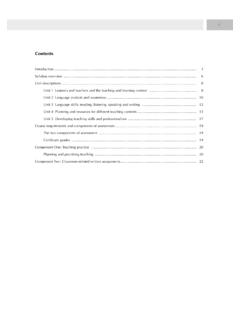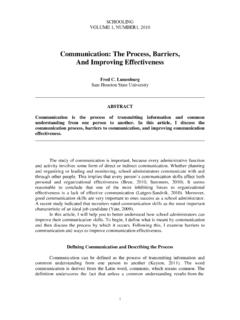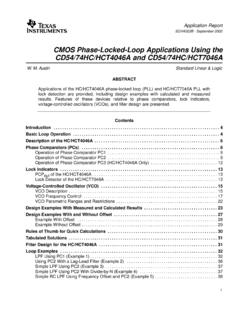Transcription of JESD204B Overview - TI.com
1 JESD204B Overview Texas Instruments High Speed Data Converter Training Outline JESD204B Standard at a Glance Benefits / Cost Timing Signals Layers Overview (Transport, Link, Physical) Deterministic Latency Subclasses JESD204B Standard at a Glance A standardized serial interface between data converters (ADCs and DACs) and logic devices (FPGAs or ASICs) Serial data rates up to Gbps Mechanism to achieve deterministic latency across the serial link Uses 8b/10b encoding for SerDes synchronization, clock recovery and DC balance JESD204B is a must for high density systems! TI Information NDA Required Feature JESD204 JESD204A JESD204B Introduction of Standard 2006 2008 2011 Maximum Lane Rate Gbps Gbps Gbps Multiple Lane Support No Yes Yes Multi-Lane Synchronization No Yes Yes Multi-Device Synchronization No Yes Yes Deterministic Latency No No Yes Harmonic Clocking No No Yes JESD204B Standard at a Glance JESD204B Benefits 5 Reduced/simplified PCB area Reduced package size Comparable power for large throughput Scalable to higher frequencies Simplified interface timing Standard interface DAC LVDS 32 lanes 4 layers JESD204 8 lanes 1 layer JESD204B Benefits 6 DAC DAC 10x10mm 144-pin BGA DAC 12x12mm 196-pin BGA Reduced/simplified PCB area Reduced package size Comparable power for large throughput Scalable to higher frequencies Simplified interface timing
2 Standard interface JESD204B Benefits 7 Reduced/simplified PCB area Reduced package size Comparable power for large throughput Scalable to higher frequencies Simplified interface timing Standard interface Driver16mACML DriverPLL@ @ 10GB/sx450mAJESD204B Benefits 8 DataClockDQDataDQCDRR efclkSpeed limited by setup/holddue to PVT variationSpeed scalable using SERDES/CDR techniquesLVDS RxSERDES RxDataClockDataCDR Reduced/simplified PCB area Reduced package size Comparable power for large throughput Scalable to higher frequencies Simplified interface timing Standard interface JESD204B Benefits Reduced/simplified PCB area Reduced package size Comparable power for large throughput Scalable to higher frequencies Simplified interface timing Standard interface 9 TimingD0 CDR0D1 CDR1 SERDES TimingJESD204B Benefits Reduced/simplified PCB area Reduced package size Comparable power for large throughput Scalable to higher frequencies Simplified interface timing Standard interface 10 11 JESD204B Costs ADCS erializerde-SerializerElastic BufferTransmitting Device (TX)Receiving Device (RX)Link LatencyADC Core Latency Increased interface latency Increased FPGA firmware complexity / licensing JESD204B Link Data Flow and Protocol Layer Diagram JESD204 BClock GeneratorFrame and LMFC Clock GeneratorDataGenerationTransport LayerParallel Serial Data MappingScrambler(optional)Link Layer8b/10b EncodingAlignment Character InsertionLink Synchronization (slave)Physical Layer(Tx)Data SerializationTransmissionFrame Clock (Tx)Local Multi-Frame Clock (Tx, LMFC) JESD204B Transmitter (Tx)
3 Device ClockSYSREFD evice ClockSYSREFBack-endDataProcessingTranspo rt LayerSerial Parallel Data MappingDe-Scrambler(optional)Link Layer8b/10b DecodingCharacter ReplacementLink Synchronization (master)Physical Layer(Rx)Data De-SerializationReceptionFrame and LMFC Clock GeneratorSYNC~Frame Clock (Rx)Local Multi-Frame Clock (Rx, LMFC) JESD204B Receiver (Rx)Serial Data*Subclass 1 JESD204 Timing Signals/ terminology TI Information NDA Required Frame Clock Data frame of the transport layer is aligned to the frame clock Frame clock period in all the TX and RX devices must be identical Local Multi-Frame Clock (LMFC) Multi-Frame is composed of K Frames LMFC is aligned to the multi-frame boundary Acts as a low-frequency reference to resolve frame clock phase ambiguity across multiple devices LMFC period in all TX and RX devices must be identical JESD204 Timing Signals/ terminology TI Information NDA Required Device Clock System clock from which the device s frame, sampling, LMFC clocks are derived (externally applied) Sample Clock Internal conversion clock of data converter Derived from Device Clock (via multipliers or dividers) Relationship to frame clock depends on packing of data into frame SYSREF Timing phase reference from which LMFC clocks are generated in subclass 1 implementations (externally applied)
4 Must be source synchronous with Device Clock Rising edge transition determines LMFC alignment JESD204 Timing Signals/ terminology TI Information NDA Required SYNC Unidirectional, Receiver-to-Transmitter Active low signaling, often referred to as SYNC~ or SYNCb Mainly used for device synchronization requests and error reporting Aligns LMFC phase in Subclass 2 devices Options available for distributing SYNC to multiple devices Transport Layer Overview Maps the data octets frames consisting of multiple octets Adds optional control bits to samples if needed Distinguishes the possible combinations of device/links/lanes/etc. Important parameters associated with transport layer include: L # of lanes per converter device M # of converters per device F # of octets per frame (per lane) S # of samples per converter per frame clock cycle CS # of control bits per conversion sample TI Information NDA Required N+1 NTransport Layer11-bit + + + 7 [10:3]Core 7 [2:0]TTTC1C0 Core 6 [10:3]Core 6 [2:0]TTTC1C0 Core 3 [10:3]Core 3 [2:0]TTTC1C0 Core 2 [10:3]Core 2 [2:0]TTTC1C0 Core 5 [10:3]Core 5 [2:0]TTTC1C0 Core 4 [10:3]Core 4 [2:0]TTTC1C0 Core 1 [10:3]Core 1 [2:0]TTTC1C0 Core 0 [10:3]Core 0 [2.]
5 0]TTTC1C0 Transport Layer (Generic Example) TI Information NDA Required Octet 3 Octet 0 Octet 1 Octet 2F=4 Octets per Frame(per lane)M=8 Converters per DeviceS=1 Samples per Frame(per converter)N=11 Converter ResolutionCS=2 Control bits per sampleN =13 Number of bits in Sample plus control bitsTails BitsRBD=User DefinedRelease Buffer DelayK=User DefinedFrames per Multi-Frame1 FrameL=4 Lanes per DeviceLane 0 Lane 1 Lane 2 Lane 3 ADC Core 0 ADC Core 1 ADC Core 6 ADC Core 7 ADC Cores 2-5 Mapping Converter Samples to FramesDeviceTI Information NDA Required Transport Layer (ex. ADS42JB49) LMFS 2221 LMFS 4211 Note: Actual ADS42JB49 implementation defines N =16 and inserts 0 s into LSBs instead of defining tail bits N+1 NTransport Layer14-bit + 0 [13:6]Core 0 [5:0]TTCore 1 [13:6]Core 1 [5:0]TTOctet 0F=1CS=0N =14L=4 Lane 0 Lane 1 Lane 2 Lane 3 ADC Core 0 ADC Core 1 DeviceN+1 NTransport Layer14-bit + 0 [13:6]Core 0 [5:0]TTCore 1 [13:6]Core 1 [5:0]TTOctet 0 Octet 1F=2CS=0N =14 Tails BitsLane 0 Lane 1 ADC Core 0 ADC Core 1 DeviceScrambling Scrambling randomizes data and spreads the spectral content to reduce spectral peaks that could cause EMI and interference problems Transport layer output may be optionally scrambled with the polynomial.
6 1 + x14 + x15 The RX descrambler self-synchronizes after receiving only two octets TX supports early-synchronization option that allows descrambler to self-synchronize during ILA TI Information NDA Required Data Link Layer 8b/10b Encoding Link Establishment, including frame and lane alignment Link Monitoring using control symbols TI Information NDA Required Data Link Layer: 8b/10b Encoding Encodes 8-bit octets into 10-bit symbols Octet to symbol mapping depends on running disparity (RD) Coding provides many bit-transitions to enable CDR techniques DC balancing enables AC coupling TI Information NDA Required Data Link Layer: Link Establishment Link Establishment accomplishes TX and RX synchronization Code Group Synchronization (CGS) Initial Frame Synchronization Initial Lane Synchronization TI Information NDA Required DataILACLKINSYSREFTx Frame LMFC BoundarytS-SYNCb-FSYNCb de-assertion latchedSYNCb assertion latchedXXXOne-shotILAV alid DataSYSREF assertion latchedFrame Clock AlignmentCode Group SynchronizationInitial Frame and Lane SynchronizationData TransmissiontS-SYNCb-FtS-SYStH-SYStD-LMF CtH-SYNCb-FtILAtD-ILAtS-SYNCbtD-K28tD-DA TAP hysical Layer.
7 Serial Lanes Physical layer defines the electrical and timing characteristics of data transfer Point-to-point, unidirectional serial interface AC or DC compliance 3 signal speed-grade variants Performance limited by SERDES, CDR and driver/receiver blocks Parameter LV-OIF-Sx15 LV-OIF-6G-SR LV-OIF-11G-SR Data Rates - Differential Output Voltage 500 1000 (mV) 400 750 (mV) 360 770 (mV) Bit Error Rate (BER) 1e-12 1e-15 1e-15 Deterministic Latency: Motivation Applications are often sensitive to the variation of system latency Synchronous sampling Multi-channel phase array alignment Gain control loop stability JESD204 and JESD204A do not achieve known/constant latency across the link across temp/supply/reboot variation Providing support for devices with internal clock dividers introduces potential for even more latency uncertainty Deterministic Latency: Achieved JESD204B achieves deterministic latency: known/constant latency Subclass 0: DL not achieved Subclass 1: DL achieved using SYSREF with strict timing Subclass 2.
8 DL achieved using SYNC~ with strict timing Deterministic Latency achieved with these architecture features SYSREF or SYNC~ are used to provide a deterministic reference phase to all devices for synchronization LMFC provides a low frequency reference to avoid frame clock phase ambiguity in the presence of link delay changes RX has an elastic buffer that absorbs link delay variation Texas Instruments recommends/supports subclass 1 LMFC phase easier to control with source synchronous SYSREF than with system synchronous SYNC~ TI Information NDA Required Subclass distinction: Whether to, and how to achieve time reference alignment (as a requirement for deterministic link latency) Subclass 0 Subclass 1 Subclass 2 Deterministic Latency Supported? No Yes Yes How to achieve Deterministic Latency? N/A Time reference (LMFC) alignment using SYSREF Time reference (LMFC) alignment using ~SYNC ADCS erializerde-SerializerElastic BufferTransmitting Device (TX)Receiving Device (RX)Link LatencyADC Core LatencyJESD204B Subclasses TI Information NDA Required Serial DataSYNC~Device clockTransmitterJESD204 BSubclass 0 ReceiverJESD204 BSubclass 0 ClockGeneratorDevice clockSUBCLASS 0 Serial DataSYNC~Device clockTransmitterJESD204 BSubclass 1 ReceiverJESD204 BSubclass 1 JESD204 BClockGeneratorSYSREFD evice ClockSYSREFD evice clockSYSREFSUBCLASS 1 Serial DataSYNC~Device clockTransmitterJESD204 BSubclass 2 ReceiverJESD204 BSubclass 2 ClockGeneratorDevice Clock~SYNCD evice clockSUBCLASS 2 Subclass Signaling Requirements TI Information NDA Required Subclass 0 Subclass 1 Subclass 2 JESD204A Backward Compatible?
9 Yes No No Deterministic Latency Supported? No Yes Yes, but speed limited SYSREF Required? No Yes No Clock and Sync Signals Device Clock SYNC~ Device Clock SYSREF SYNC~ Device Clock SYNC~ SYNC~ is Timing Critical? No No Yes Interface Hardware Complexity Least Most Moderate Link Latency 8-100 sample clocks (non-deterministic) 15-120 sample clocks (deterministic) Choosing a Subclass TI Information NDA Required Subclass 0 Subclass 1 Subclass 2 Wireless Comms. Repeater - Narrowband (<125 MSPS ADC) - No DL requirements Software Defined Radio - Wideband - DL required Radar, Imaging Sensor - Wideband (>250 MSPS ADC) - DL required + Multi-Device Sync. Oscilloscope, Spectrum Analyzer - Wideband (> 250 MSPS ADC) No DL Required DL Required Texas Instruments JESD204B device all support subclass 1 while some support all 3 subclasses >250 MSPS ADC <=250 MSPS ADC Subclass by Application Examples Summary JESD204: Standard serial data interface for data converters JESD204B subclasses offer 3 implementation variations Transport Layer defines data framing into serial lanes Link layer defines encoding, synchronization and data monitoring Physical layer defines the electrical and timing performance Deterministic latency achieved with subclasses 1, 2 and is required for known/constant latency through link TI Information NDA Required More Educational Resources IMPORTANTNOTICET exas

















